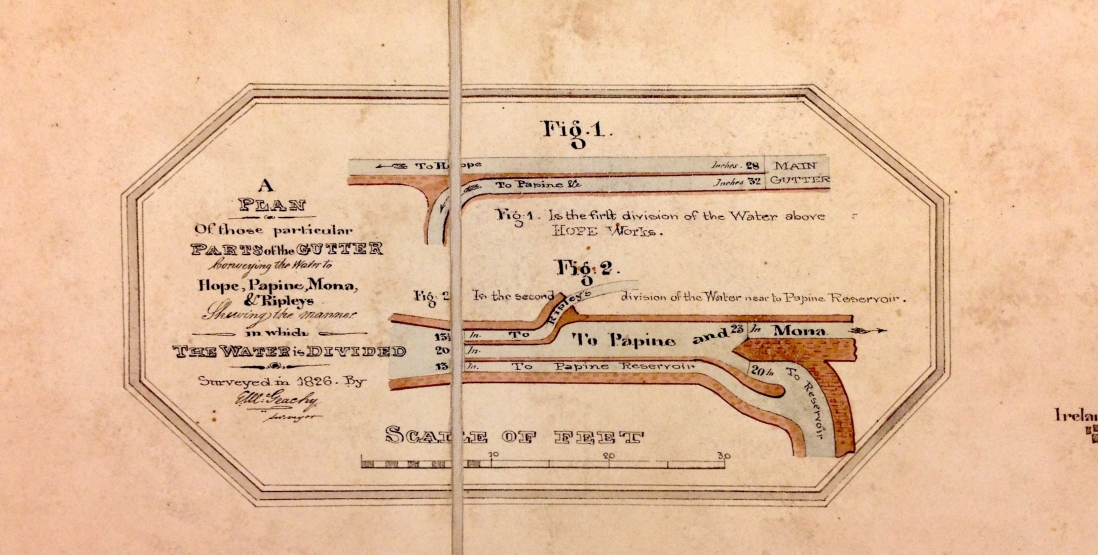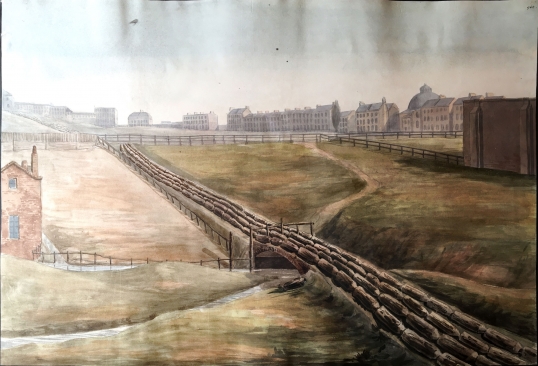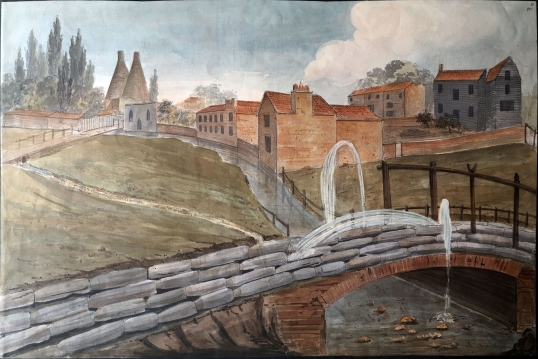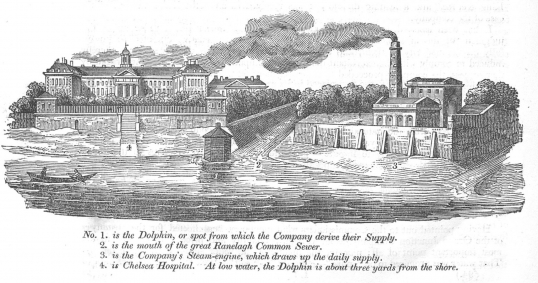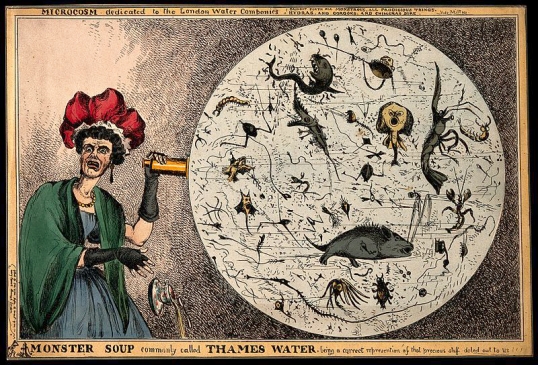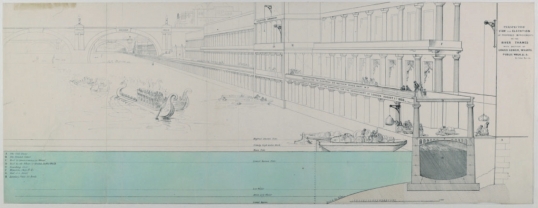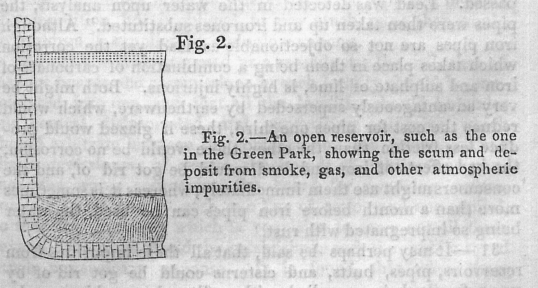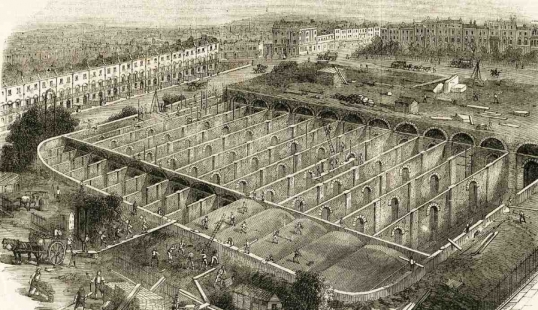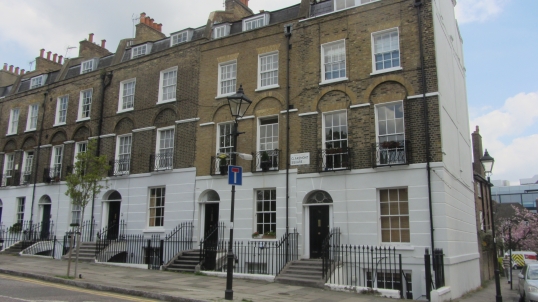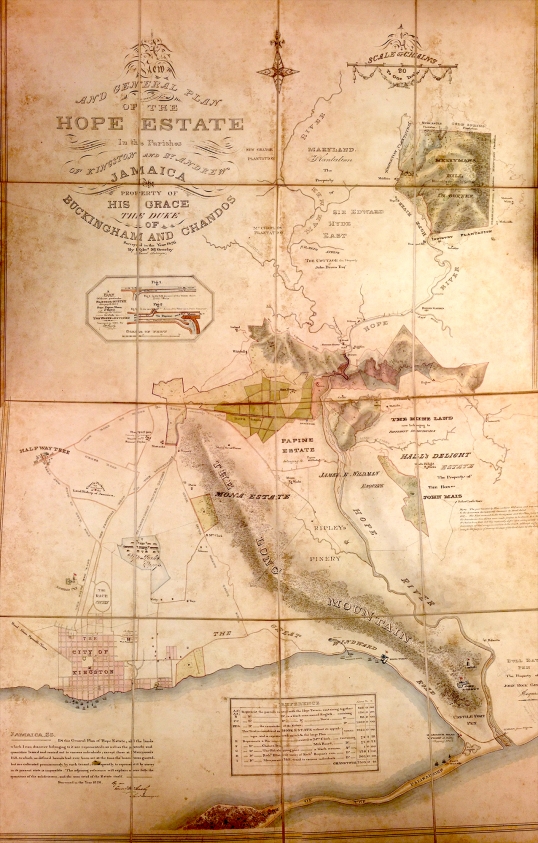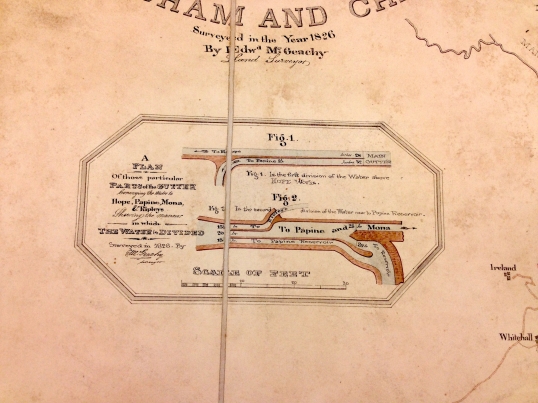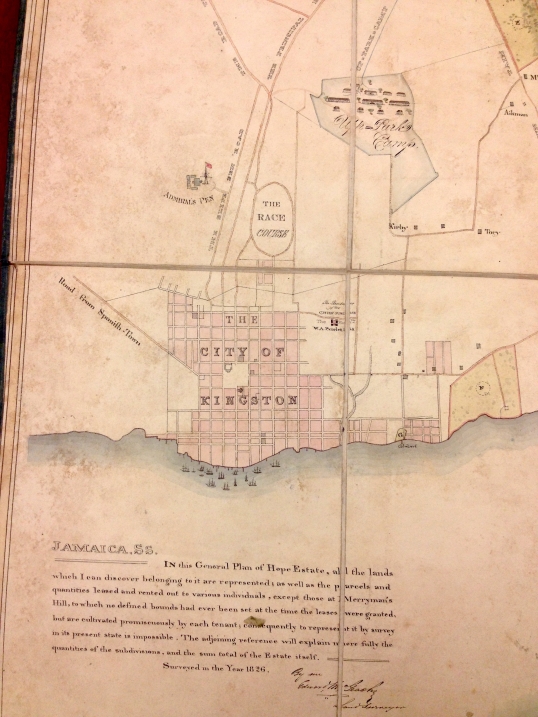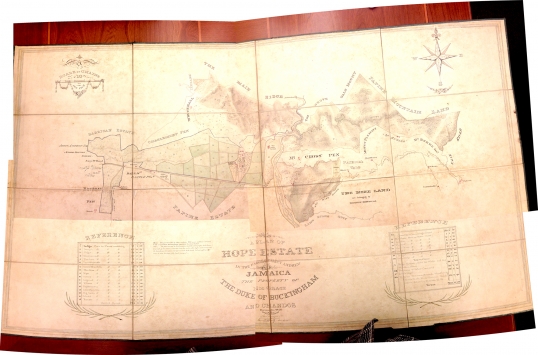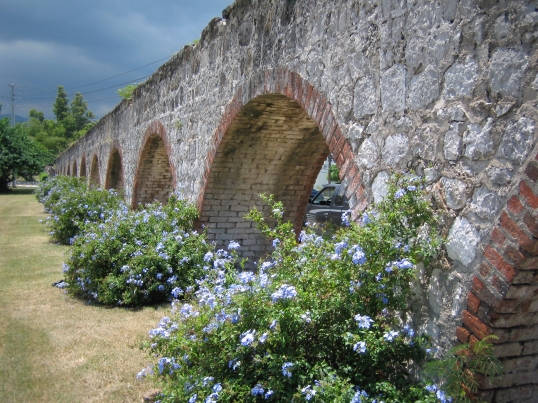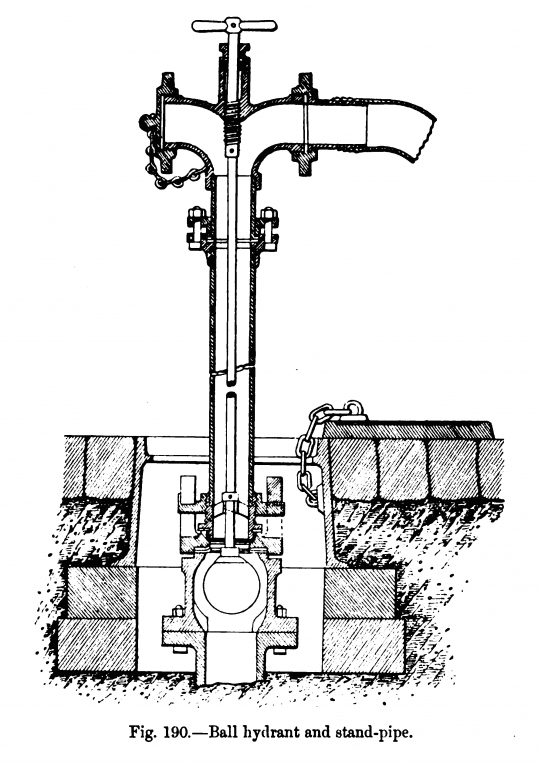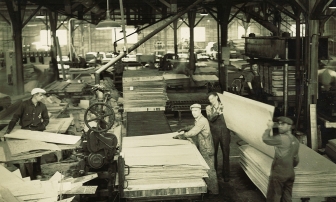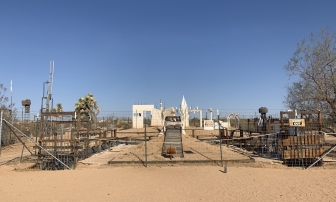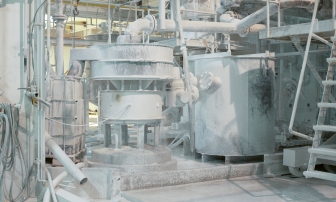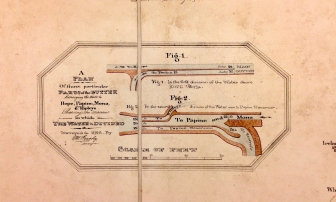Pipes, Provision, Profits, Privatization: The Materials of Water Infrastructure in Nineteenth-Century Kingston, Jamaica, and London, England
Edward McGeachy, A New and General Plan of the Hope Estate, 1826, detail.
Huntington Library, Stowe Papers: Stowe West Indian Estates (Grenville & Brydges), West Indies Box.Water is a vital element of urban infrastructure. What constitutes healthy water, and who can expect it as a basic right, however, has differed historically, based on shifting ideas about who counts as a citizen. In the phased end of slavery, reconsiderations of British subjects’ political status reshaped how water defined cities during the course of the nineteenth century. By parliamentary mandate in the early nineteenth century, water companies overhauled London’s system with cast-iron pipes. Across the Atlantic Ocean, in Kingston, Jamaica, a single chartered corporation financed largely by London-based investors fitted out the city with lead pipes. While the political situation of slavery was socially toxic, its analog—material infrastructure—continued after emancipation in the form of lead conduits that contaminated water supply. Capital-intensive but chemically inactive cast-iron pipes affirmed the status of London’s private citizenry by using less risky metal. Conceptions of freedom and defining water as a public or private good separated the two cities; the political and material differences were manifest in whether iron or lead pipes delivered water.
Water pipes, and the configuration of cities to supply water, helped to create a bodily and political definition of nineteenth-century private citizenship. As private water companies experimented with different materials and construction for water conveyance, Londoners rallied against this change on the grounds that clean, nontoxic water, conducted through iron pipes, ought to be freely available to free subjects in a liberally ordered city; water was a public amenity. In contrast, colonial Kingston, Jamaica, did not receive dependable supplies of clean water until nearly the middle of the nineteenth century, due to handshake agreements that had been subverted by intervening private interests. When the system was finally installed, the healthfulness of the water, carried through lead pipes, was dubious. Nevertheless, Kingston’s water infrastructure was government owned and operated before the system in London was municipalized. In an implicit signal of who could be trusted to manage their own affairs as individual economic agents, as opposed to populations that would be treated as monolithic groups requiring management from above, Londoners regarded state-run services warily and retained their private infrastructural corporations, while Kingstonians were subject to the single, top-down bureaucracy. Kingston’s apparatus for water distribution was implemented directly following emancipation, in the 1840s, and improved after the Morant Bay Uprising in 1865 enabled the city’s white elites to consolidate power to prevent the ostensibly newly enfranchised Black and mixed-race population from claiming rights. A paternalistic, white-minority-led government deemed these racialized citizens unruly and thus incapable of acting as a public. If the users of Kingston’s water system benefited, they did so at the cost of social equity. The extent of people’s political empowerment was defined by the same authorities vested with the power to decide how London’s and Kingston’s inhabitants accessed water. In both cities, water thus became an indicator of self-determination.
Just as water distribution structured the layout, organization, and personal perception of these two sites at the urban scale, the effects of construction of water supply systems also registered at the scale of architecture. While the scope of this essay is generally focused on the former, speculative builders and architects found ways of reshaping these cities on the more atomized level of individual buildings and spaces, in houses, churches, pump houses for the water companies, and holding tanks and reservoirs. William Chadwell Mylne’s St. Mark’s Church, in the Clerkenwell neighborhood of London, for example—a development financed by the New River Company—is an outwardly Gothic assemblage with smooth iron pipes functioning as columns in its interior. Given New River’s subterranean network of iron pipes underground, it is difficult to deny the affinity between the building’s materiality with the company’s currency in trade. The building is a visible efflorescence of the underground, metropolis-wide constructed system. In Kingston as well, one of the more notable urban landmarks at a significant urban intersection, Cross Roads (also known as Montgomery Corner), once housed two above-ground reservoirs, each with a capacity of two million gallons. The presence of water infrastructure thus would have been apparent to urban pedestrians in these two cities.
The histories of water provision and building regulations in Kingston and London, approached through a comparative lens, demonstrate how entrepreneurs’ and technocrats’ interventions into these two cities’ forms conditioned conceptions of humanity. A burgeoning subfield of infrastructural studies in recent years has highlighted the significant ways that water has been manipulated to legitimate or deny people’s political status.1 Anticipation and anxiety guided decisions about where and how to build, who had access to these systems, and under what circumstances governmental entities formalized control over the systems’ administration. Access to water gradually developed into an expected amenity of urban citizenship, but not all who received water from their municipality qualified to be citizens. The political theorist Anthony Bogues has argued that post-emancipation Jamaican British colonial administrators held formerly enslaved people to be “subjects” not yet worthy of the designation “citizens.”2 Technically, anyone who was a parish rector, or owned a £6 freehold or paid £3 in taxes per year, or met other financial thresholds could be a citizen, but those were significant barriers for recently freed people with no wealth or means.3 Newly freed Black Jamaicans had become subjects in 1838, but they were still not full-fledged citizens. The definition of British citizenship has never been officially codified, so criteria for attaining that status were likewise indeterminate.4 Following Bogues’s discussion of that delineation, potable water offers material evidence for defining urban subjecthood and citizenship. The temporal scope of this essay spans periods before and after emancipation. It concentrates on the rights that public water infrastructure signified for individuals’ political standing. Yet, by offering those provisions, the authorities that administered that infrastructure exerted control over amenities like water—to confer or withhold them. Governmental entities were accountable to at least some conception of public interest, but the private companies that provided those services were beholden only to the interests of shareholders.
As urban technologies developed, populations began to expect higher standards of living in London and Kingston. At the same time that governmental reformers wrangled with conservatives over political representation across the ever-expanding area of London, colonial administrators in Jamaica sought to integrate a newly freed population but to maintain that population’s quiescence. Formerly enslaved people had begun to exercise their political will, and it was incumbent on the bicameral island legislature to resolve how and to whom to afford rights.5 Prospects of newly enfranchising people pervaded both London’s and Kingston’s politics, albeit under vastly different circumstances—colonial rule in Kingston and corporate influence in London.6 Analysis of the materials used for urban water supply demonstrates how physical infrastructures have defined people’s expectations of public resources and their views about who should be responsible for their provision. Certain segments of these respective cities’ populations had access to certain technologies, and others were prohibited access. By identifying these relationships—the tangible corollaries to people’s political status—we gain insights into why basic human rights include some technologies, and bodily risk, whereas others are the exclusive province of selected social groups. The scholar of ecological colonialism Malcolm Ferdinand demonstrates how quantities and quality of water supply have been used as a weapon in the colonial apparatus: first, in the Zong massacre of 1781, in which some 130 enslaved captives were thrown overboard due to a perceived water shortage; second, in the persistent pollution of Caribbean bodies of water; and third, in the archetype of Maroons, who achieve self-sufficiency by locating sources of spring water.7 With water as the nexus between groups and across geographies, we can understand how the chemical composition of water has played a role in shaping colonial systems.
In Kingston, freed Jamaicans of African descent experienced racism, new policies aimed at reducing labor costs by importing South Asian laborers, and other British colonial means of oppression that Londoners did not face. Members of the political class invested their capital in London, where they lived. Therefore, systems and infrastructures existed there in the nineteenth century but not in Kingston, where plenty of capital flowed, but much of it returned to the absentee landholders who resided across the ocean most of the time. Political will in London to shape and reshape the city’s infrastructure came easily, because the people who paid for the water system there also received their water from it. In Kingston, on the other hand, most of the water company’s backers were not residents of Kingston but had instead invested remotely, continuing the patterns of absenteeism and an extraction economy. Yet, in spite of the incommensurability wrought by enslavement, Kingstonians and Londoners occupied positions that, while radically distinct, bear comparison on the grounds that both were subjects whose political viability was predicated on their capacity to generate income for the owning class, as consumers, laborers, or both. From the perspective of water-using subjects, the capacity to decide when, where, and how to consume is a factor in self-determination, dependent upon reliable access to water. In a structural arrangement in which corporations supply vital commodities to paying subjects, people defined their own bodies—as consumers—against corporate ones.8 If not exactly emancipatory, these social relations between individuals and corporations created conditions for self-realization, in which the political status of both Londoners and Kingstonians emerged from their interactions with commodity suppliers.
Iron
When the London water companies replaced the metropolis’s old water network of wooden pipes with iron ones in the early nineteenth century, architects had long considered the water system ripe for their intervening expertise. John Soane derisively included illustrations of the wooden water pipes in his Royal Academy lectures (figs. 1 & 2).9 The pipes’ exaggerated leaks illustrated what Soane saw as the inferiority of London’s water system in comparison with the urban splendor—predicated on the infrastructure—of Paris and other continental European cities. Before Soane, Christopher Wren had touted his skills as both an architect and physician uniquely suited to redesigning the metropolis’s water infrastructure. Wren, employed by the New River Company between 1680 and 1700, made a direct analogy between the metropolis’s potable circulatory system and human biology.10 Even though the link between water and health was not self-evident, other observers also wrote about London’s water system using the metaphor of blood and veins.11 Wooden pipes needed constant replacement when the bored wooden cylinders burst, meaning that they needed to be close to the ground’s surface and could not be buried underneath buildings due to the necessity of frequent maintenance. Further, their exterior diameters were constrained by the size of logs that could be made into pipes, and their internal diameters, likewise, could only be as large as the walls of the timber would structurally allow, given the internal pressure of water flowing through. That pressure resulted in constant leaks, which could be difficult to locate. On a surveying trip to London to consider how best to renovate Paris’s system, the French engineer-in-chief of the Conseil Général des Ponts et Chaussées, Louis Bruyère, found the London water to have a “very disagreeable taste to which the wooden pipes can contribute.”12 He reported that people generally boiled the water they received in order to get rid of the acrid taste. He also noted the frequent disruptions to street traffic that digging up leaking wooden pipes caused. Bruyère therefore found nothing to admire, much less imitate, in London’s network, despite its spatial coverage. The water companies’ reliance on wood had further effects, including the necessity to maintain property along the Thames for wharves to unload logs and bore them into hollow pipes.
Fig. 1. Soane Office, (drawn by George Basevi), “New River Company, Spa Fields: Wooden Water Pipes,” 1814.
© Sir John Soane’s Museum, London.
Fig. 2. Soane Office, (drawn by George Basevi), “Royal Academy Lecture: [Wooden] Water Pipes at Bagnigge Wells,” 1815.
© Sir John Soane’s Museum, London.
When a series of technological developments over the course of the eighteenth century made cast iron more readily available, the water companies began to weigh the advantages of replacing their underground wooden pipe networks with iron ones. A further consideration was that continuous international armed conflicts from the eighteenth century into the first decade of the nineteenth century had depleted the supply of readily available wood.13 Those factors made wooden pipes far less cost-effective than when they had been treated as more or less expendable pieces of equipment.
After more than two centuries of conveying water through wooden pipes, the London authorities held hearings and chemical assays to determine the viability of replacing wood with iron. The parliamentarian Michael Angelo Taylor, who took an interest in urban infrastructure, sponsored the Metropolitan Paving Act in 1817.14 His legislation mandated that all of the London companies replace wooden pipes with iron ones. That system-wide substitution redounded to the benefit of (generally) newer companies whose networks already included iron pipes, while the older companies would be liable for greater expenses to replace their wooden pipe systems. The newer companies thus expanded into the growing areas of posh development. The results were companies that chose their customers, rather than the reverse.
The Grand Junction Water Works had proffered stone pipes as an alternative on the grounds that they were “a purer conduit than anything before laid down, there being a strong prejudice at that time against the use of iron that they were induced to adopt stone.”15 Stone proved unable to withstand high pressures, however, resulting in embarrassment for several highly regarded engineers as well as extended legal wrangling.16 Nevertheless, the effort to find a material that would transmit “pure” water is meaningful. John Wright targeted Grand Junction in his scathing The Dolphin, or, Grand Junction Nuisance. In an 1828 pamphlet the painter-inventor John Martin annotated the water companies’ advertisements with countervailing quotations drawing attention to the filthiness of Grand Junction’s water in gruesome detail, replete with graphic testimonials (figs. 3–5).17 Clean water, supplied through pipes made of inert materials, would go hand in hand with business practices that would not take undue advantage of consumers.
Fig. 3. “Grand Scheme of Public Utility,” Grand Junction Waterworks Company.
House of Lords, Report of the Commissioners on Appointed by His Majesty to Inquire into the State of the Supply of Water in the Metropolis (London, 1828).
Fig. 4. William Heath, Monster Soup Commonly Called Thames Water, ca. 1828.
Fig. 5. “Plan for Supplying with Pure Water the Cities of London and Westminster, and of Materially Improving and Beautifying the Western Parts of the Metropolis.”
John Martin, Plan for Supplying with Pure Water the Cities of London and Westminster, and of Materially Improving and Beautifying the Western Parts of the Metropolis (London, 1828).
For consumers, who were both sources of capital and political constituents, the British “constitution,” a set of informally defined principles, included not only an indelible investment in a sense of place (and property, to go along with it) but also “liberty” from government itself—perhaps the very reason the “constitution” remained unwritten (or more properly, as the scholar Anthony King has argued, not codified).18 The maxim that held that “a man’s home is his castle” gave license to consumers to consider the domestic sphere as an autonomous domain, even after plugging into wider networks like roads and water had developed into a norm.19 Applying high-minded notions of the “constitution” to markets, monopolies became infringements upon liberty. Adam Smith suggested that “public works” like highways and canals might be exceptions to his repudiation of monopolies, but among the exceptions to that exception was the “trade of bringing water for the supply of a great city,” which would benefit from management by non-monopolistic private companies.20 According to Smith, there was only one way to provide water, so companies could bear the pressures of a free market without assigning a charter-granting monopoly power. (Fire insurance fell into this category as well.) Yet, as the cartel-like water companies competed among one another for distribution areas, urban water consumers objected to their lack of choice in water suppliers as an infringement on their self-definition as free people. The Anti-Water-Monopoly Association assumed precisely this as their mission, adopting the language of “liberty” to demand a competitive marketplace for the provision of water.21 The mechanism for depriving people of that right was the mandated replacement of wooden pipes with iron ones.
The right to clean water appears here as a logical extension of the construct of liberties that undergirded the concept of sovereign, free persons.22 The notion of “freedom” was applied to water, but in that context it had a very different meaning: a House of Lords report indicated that it should be “free from insects and all suspended matters, … free from extraneous substances, . . . free from the suspicion of general insalubrity.”23 The coincidence of these freedoms was contingent on a water system that would provide good-quality supply to all who merited it—in this case, to all who could pay for it. Guarantees of rights were thus economically circumscribed.
By the 1820s, paying customers demanded greater volumes of water than the companies had the capacity to provide at that point. Through the 1810s, groups like the Anti-Water-Monopoly Association brought consumers together to exert their collective rights in terms of what they expected the water companies to supply: dependable water supply, especially in relation to security from fire.24 These activists demanded “clear,” “pure,” or “good” water, but, as the historian Leslie Tomory explains, those expectations were predicated on a historically contingent conception of “purity.”25 The companies were “concerned less with filtration, and much more with preventing impurities that impinged on the taste and odor of the water,” such as “leaves, weeds, and mud, but from the 1780s, likely influenced by changes in medical thinking, [conceptions of purity] became increasingly concerned with animal matter and then, beginning in 1800, with privies located close to the river.”26 Consumers directed their attention principally to others bathing upstream, which, they complained, introduced contaminants (putting aside, Tomory notes, the proximity of sites of livestock or even human waste to riverbanks).27
The replacement of wooden pipes with iron ones coincided with emerging attention to the cleanliness of water, and the water companies carried out tests to determine the potential effects of the new technologies. Some early skepticism about iron arose from what one engineer described as “material incrustation” inside the pipes, resulting from slow-moving water.28 William Chadwell Mylne, Surveyor of the New River Waterworks and the person responsible for the conversion to iron, recognized the “many prejudices against the use of iron pipes when they were first used,” because of corrosion of the metal from oxidation if the pipes were not airtight.29 A doctor testified to Parliament that “both leaden cisterns and pipes, and iron pipes, are corroded occasionally by water.”30 These water company officials did not comment on pipes’ health effects, but they sought to tamp down anxieties by ensuring consumers that iron pipes would last fifty years before their interiors would even need cleaning.
Generally, though, before the middle of the nineteenth century commentators rarely expressed concern that the pipes themselves could introduce contaminants to adulterate the supply. A group that called itself the “Metropolitan Working Classes’ Association, [sic] for Improving the Public Health” issued a report in 1847 on water provision (figs. 6–8).31 The pamphlet was part of a self-help series that included manuals on bathing and personal cleanliness, one on household cleanliness, another on ventilation of interiors, another on exercise and recreation, and so on. Water Supply; Especially for the Working Classes pointed to both iron and lead as culprits in the contamination of domestic water, stating that “severe illness” had resulted from lead leaching into water. “Although iron pipes are not so objectionable as lead,” the text warned, “yet the corrosion which takes place in them being a combination of carbonate of iron and sulphate of lime, is highly injurious.” In place of metals, the Association recommended using glazed ceramic pipes. The following decade, one chemist published alarming findings, gathered in a number of English towns, of visibly off-color samples of water drawn from iron pipes.32 Despite subsequent findings that the pipes were not the source of contamination, such reports affirmed consumers’ wariness regarding metal introducing unhealthy particles into water.
Fig. 6. “…the deterioration which water undergoes from the deposit at the bottom of the water tank, and the scum on the surface.”
The Metropolitan Working Classes’ Association, for Improving the Public Health, Water Supply, Especially for the Working Classes (London, 1847).
Fig. 7. “An open reservoir, such as the one in the Green Park, showing the scum and deposit from smoke, gas, and other atmospheric impurities.”
The Metropolitan Working Classes’ Association, for Improving the Public Health, Water Supply, Especially for the Working Classes (London, 1847).
Fig. 8. “A water pipe when filled” and “A water pipe when empty, showing the settlement at the bottom and the corrosion at the top, all of which is swept into the water-butt [cistern] at the time of supply.”
The Metropolitan Working Classes’ Association, for Improving the Public Health, Water Supply, Especially for the Working Classes (London, 1847).
The ramifications of the shift from wood to iron extended beyond health and water pressure to physical construction. The water companies’ growing influence on the form of the metropolis signaled a growing presence of infrastructural systems in urban dwellers’ lives, even as the material technologies could be increasingly concealed. As London expanded and speculative real estate projects accelerated, the New River Waterworks took advantage of its ability to bury pipes underground (figs. 9 & 10). Unencumbered by the frequent need to dig up burst wooden pipes, the company initiated a large, neighborhood-scale building campaign on fields previously reserved for its wooden pipes.
Fig. 9. “Service Reservoir of the New River Company, Claremont-Square, Pentonville.”
The Illustrated London News (22 November 1856), 522. Wellcome Collection.
Fig. 10. W.C. Mylne, et. al., Claremont Square, London, ca. 1820s.
Photograph by Kevin Plummer.
On its surface, the New River company’s foray into building construction was only a by-product of the wider narrative of consumers exerting agency to demand cleaner, higher-quality water supply based on the use of safe materials. But since infrastructure is so often invisible even to those who use it most habitually, the New River Estate represented a vision of urban development that attached an architectural image to the newly efficient, hygienic metropolis. The New River firm signaled its urban ambitions by naming the various locations after episodes of its corporate history: Myddelton Square, Amwell Street, Chadwell Street, and so on.33 One correspondent for The Builder described the area as having “some of the most salubrious and pleasant squares and semi-suburban retreats that are to be found in the metropolis.”34 An advertisement for investors to develop the area touted “valuable and important freehold properties … based on the rental value of property within the district over which it [New River] has the exclusive right of supply,” and purchasers would receive shares in both the land development scheme and the water company.35 A more skeptical editorial writer cited the water company’s vast and growing revenues from its status as both a “water-lord” and a “land-lord,” offering sarcastic congratulations to tenants who would now pay for water that, quoting from a recent governmental report, “is better than it was, but its inadequacy is still the cause of much unhealthiness and misery.”36 The company’s gestures, and the public response to them, point toward an increasingly diversifying enterprise that sought to reshape the city both below and above ground, invisibly and visibly.
The architecture of the new district was utilitarian and repetitive, in alignment with the characteristics of a utility service provider. Mylne, the company’s Surveyor, would plan the urban swath, but plots were subsequently sold off to builders.37 The company had initially come into possession of the land that would come to be known as New River Head in Clerkenwell by purchasing a freehold in the seventeenth and eighteenth centuries for its reservoirs and distribution pipes, acting first and settling disputes as they arose.38 Having completed the project of replacing its pipes, New River gathered capital by mortgaging the land it held in Clerkenwell.39 The company received half a million pounds from a number of contractors who leased out parts of the estate and built on that land in the 1820s. Construction on the estate proceeded through successive periods of booms and lulls through the mid-nineteenth century.
The expectation of not just clean water but a correlative urban aesthetics that emerged during this period encapsulates the broadening expectations of services that citizens of London considered to be basic amenities. Apart from the financial prospects of building bourgeois houses, the water companies profited from converting wooden pipes to iron due to lower maintenance costs, and consumers received more reliable water supply. The wooden pipes had been liable to burst under internal water pressure, causing waste, leakage, and lower pressure down the line. Their permeability also allowed opportunities for foreign substances to infiltrate the water supply. Iron remedied all of those problems. Promotional literature of the Grand Junction Waterworks, for example, drew a connection between the new iron-pipe network’s improvements in regard to fire safety and the cleanliness of the water: “Ravages of fire are increased by delay and scanty supply. No houses watered by this Company can suffer in these respects. Their water being perfectly clear, would not, in case of fire, tarnish the furniture, as that does, which is now supplied to the fire engines, loaded with the filth of the kennel.”40 Even if consumers’ houses caught fire, they could rest assured that the water used for firefighting would not contribute to the mess. Guarantee of dependable water supply meant freedom from worrying about damage to one’s valuable possessions, as well as to one’s health.
The provisions that people across British dominions could expect from their government were contingent on factors of geography and space as much as upon class and race. Living in the metropole afforded citizens privileges that did not obtain in other parts of the empire. In White Freedom: The Racial History of an Idea, Tyler Stovall discusses a gradation in which “the whiter one was, the more free one was.”41 Stovall, like Anthony Bogues (cited earlier), draws a distinction between “white citizenship and nonwhite subjecthood,” but for Stovall the prerogatives of racial whiteness have traditionally included freedom. By the mid-nineteenth century the metropolitan citizenry (or at least its bourgeois segments) could demand a right to healthy water, pumped through inert iron pipes. This was not the case in British colonies, however. In the colonial setting of nineteenth-century Kingston, Jamaica, where the population could not presume a hygienic water supply, pipes were generally made of lead. Black people’s rights were those afforded to subjects, not citizens, even after nominal emancipation. It does not seem too much of a stretch, then, to conjecture that Stovall’s insights regarding the correlation between whiteness and liberal rights also apply to the right to water service. Taking water as a material analog to the privileges of the imperial state thus offers a gauge for measuring the efficacy of political pressure: who had access to water, at what costs, and through what conduits.
Lead
Lead is as ubiquitous in histories of urban water infrastructure as any material. It is easily moldable and solderable, and it resists corrosion or leaks, but for almost as long as lead has been used for pipes, observers have been wary of the detrimental health effects from the heavy metal’s contact with and presence in the water conveyed. The London water system had employed subsidiary lead supply pipes, or “ferrils,” attached to wooden mains but had generally phased out lead with the transition to cast iron.42 Yet in the late 1840s, just as the Metropolitan Working Classes’ Association for Improving the Public Health was making the case for eliminating lead (and iron) from London’s water distribution system, as discussed above, an entire network in Kingston, Jamaica was being constructed with lead pipes.
In contrast to the London water system, Kingston’s water service targeted a much more restricted group of people. Yet water, as a substance that we may analyze—in terms historical, sociological, or otherwise—is only as meaningful as the conduits through which it flows. Kim De Wolff and Rina C. Faletti, in their introduction to the 2022 collection Hydrohumanities, observe that, generally, “existing discussions operate under the assumption that water—in the singular—is a resource to be managed or commodified, whether equitably or otherwise.”43 The cases of London and its cast-iron pipes and of Kingston and its lead ones both repeat and challenge this convention. Discussing the metals from which water pipes are made diverts attention from water itself and thus, admittedly, construes it as a commodity. Yet studying these other materials is precisely the means by which we may differentiate the water of London from that of Kingston. The pipes, in other words, indicate the ways in which Britons across the transatlantic gap did not regard water as uniform or homogeneous. While the London water companies’ uses of customers’ funds prompted allegations of corporate exploitation, the social, spatial, and material configuration of post-emancipation Kingston systemically enervated the majority of consumers along racial lines. While there is no evidence to suggest that Kingstonians would have objected to lead piping or understood it to be an inferior expedient, the pipes bore the legacy of a society founded upon racial hierarchy.
In 1827, the agitator John Wright, a white citizen of London, invoked slavery as he sought to demonstrate the injustices committed upon residents of London by cartelized water companies. He complained that the corporations were treating customers, land, and pipe infrastructure alike, as though they were entitled property eligible for trade between “one set of monopolists to another, like so many negroes on a West Indian estate.”44 Grossly inexact analogies to enslaved workers aside, Wright’s protest expressed the dissatisfaction of having been objectified—in his case, deprived of the agency to choose the supplier that he preferred to supply his water and receive his payment. Wright’s complaint was that the companies’ spatial apportionment of the city released them from accountability to their consumers, who had become commodities for the water companies to exchange among one another. The free market was the province of the corporations, not the consumers whose prerogative it was to make the market “free.”
Wright was not the only commentator to conflate water supply, deprivation of rights, and racial enslavement. With somewhat more reserve, the engineer William Matthews, likewise a white Londoner, celebrated metropolitan citizens’ freedom to delegate water provision to utility suppliers.45 According to Matthews, those who performed the “painful and toilsome labour” of procuring their own water were decidedly not “the inhabitants of nearly all the capitals … , cities and towns on the continent of Europe.” He regarded such practices to be “nearly, if not quite, equivalent to positive slavery,” a comparison that made him appreciate the amenities of the metropole: “How striking the contrast, how inestimably superior, in every point of view, the methods introduced by science and art, to afford the abundant supply of water to London, Edinburgh, and other great cities in Britain!” Without putting it in so many words, Matthews was declaring the right to hygienic water supply, without having to exhaust oneself to procure it for one segment of the population exclusive of another. Writing at precisely the moment that the British government was compensating enslavers for releasing their claims to Black people’s compulsory labor, Matthews expressed pride in the human labor saved by London’s mechanical distribution system. Plantation records, indeed, routinely listed “water carrier” among the occupations of enslaved people of all ages and genders.46 Technological innovation was the province of—and ought to ease the burden of—citizens of the metropole, while the lot of colonial subjects was physical exertion.
In comparison to London, efforts to bring water to Kingston, Jamaica, stretched from the 1750s to the 1860s. Water flowed through lead rather than iron pipes. During that time, the abundance of uncompensated labor may have diminished the demand for material infrastructure among white financiers. After failed starts and complications engendered by property disputes, a network of pipes finally brought water to residents of urban Kingston in the second half of the nineteenth century. Although recognition of lead’s toxicity was only formalized into legal prohibitions much later, a wide contingent of contemporary medical experts warned against the metal’s damaging effects. The detection of the causes of lead poisoning, indeed, has historical ties to Caribbean geography, described below. The story of Kingston’s water infrastructure, therefore, conveys the differences between and across racial, geographic, and material divides engendered by transatlantic colonialism.
The choice of lead did not signal a deliberately hostile act to the Jamaican population; lead pipes continued to be used in geographically and demographically diverse settings through the late twentieth century. However, if the primary purpose of London’s conversion to iron water pipes was to withstand the higher pressures of steam-driven pumps so as to provide higher-velocity, more dependable delivery, Kingston’s status as a colonial city—whose majority population had recently been deemed slaves on account of their race—made access to any of that technology inconceivable. Conveying water to urban Jamaica was less of a priority since the island’s economy depended primarily on rural sugarcane production facilities operated by enslaved Black workers.47 Cities functioned mainly as export sites and only secondarily for other purposes. While infrastructure for bringing water to Kingston on a large scale had been discussed for nearly a century, a conveyance system was not realized until about 1850—and then, in the most expedient manner possible. If we take the engineer William Matthews at his word that procuring water manually was harder work than most free people would be willing to undertake, the Kingston water system’s realization after emancipation is logical: once the formerly enslaved Jamaican proletariat needed to be paid for their labor, delegating that labor to nonhuman mechanisms and materials made more sense to those whose business ventures required transportation of large, heavy quantities of water.
Knowledge of lead’s deleterious effects dates back to Vitruvius, who wrote, “Water from clay pipes is much more wholesome than that which is conducted through lead pipes, because lead is found to be harmful… . This we can exemplify from our plumbers, since in them the natural colour of the body is replaced by a deep pallor… . Hence, water ought by no means to be conducted in lead pipes.”48 The fifth-century-CE author Palladius also cautioned that lead pipes were “noxious.”49 Closer to the time of this narrative, in 1767, the physician George Baker attributed what he called the “Devonshire colic” to traces of lead in apple cider.50 He recognized the similarity of the gruesome “colic” symptoms to a disease he had heard about from the Caribbean, where problems arose after residents drank large amounts of acidic citrus juice, which had likely been stored in lead containers.51 Baker reassured his readers that cider’s medicinal benefits—having been identified as an effective treatment for scurvy—remained unassailable. The cause of the disease, though, was “fraudulent, or accidental, adulteration” of acidic beverages “com[ing] in contact with no small quantity of this poisonous mineral,” that is, lead.52
Historically, lead’s toxicity was more often perceived than immediately identified.53 In the 1980s, a team led by anthropologist Jerome S. Handler retroactively diagnosed “a previously unappreciated epidemic of lead poisoning in early West Indian slave societies” based on evidence of heavy traces of lead in the skeletal remains of enslaved people from the Newton labor camp in Barbados, though the study’s authors stipulate that their findings are generally applicable across the Caribbean archipelago.54 The “dry bellyache,” as a variety of sources designated lead poisoning, might have derived from contaminated ingestible substances, the use of lead-glazed food containers or cookware, or lead-lined cisterns for collecting rainwater. Distilling equipment, however, was the most likely point of contact. Lead’s malleability made it easy to work into the distinctive shapes of stills, but the metal leached into rum at high rates due to a combination of the corrosiveness of alcohol and the heat of the distillation process. While this type of lead ingestion affected a wider population across the rum-making Americas than just enslaved Black people, Handler et al. explain that enslaved people were given “Low-wine.”55 Also called “new rum,” this spirit was more noxious and likely to cause lead poisoning than more highly refined aged rum, which white people reserved for themselves. Distilleries, moreover, were precedents for the construction of larger water systems across the Caribbean. In Barbados today, incidentally, “lead pipe” is more often associated with a sweet coconut bread than either water or rum. Nevertheless, the name evokes the meanings attached to lead: prosaic, hard, and heavy, but also a source of nourishment.
The story of water infrastructure in Jamaica dates back to the colony’s formation under English administration. In 1655, an army regiment established command in Jamaica against any remaining Spanish detachments as part of Oliver Cromwell’s “Western Design.”56 Reservoirs, dams and weirs, aqueducts, and channels—all, of course, built by enslaved laborers—were the common technologies that plantation owners used to control the geographic location, directional flow, elevation, and force of water.57 These pieces of physical infrastructure would all become consequential factors in the subsequent initiatives for urban water supply. On the land that is now urban Kingston, primarily the area known as the Liguanea Plain, situated to the city’s north at the foot of Blue Mountains, the soldiers set up farms to supplement other food sources, which were otherwise insufficient. The territory was also advantageous to the English as a source of water, with rivers and springs along which they began planting. Yields were minimal; Spanish forces proved not to be as large a threat as the English feared, but the English troops were not eager farmers and resisted their superiors’ demands to perform agricultural labor on the officers’ lands.
The plantation and water source claimed by Major Richard Hope would have effects on urban water supply in Jamaica from English colonization in the seventeenth century through to today. More successfully than others, Hope established a plantation to grow cocoa, indigo, and food crops.58 Ann Hope, Richard’s wife, immigrated to an estate that, by 1672, covered more than one thousand acres. With an acceleration of the slave trade, the Black population of the area multiplied during this time.59 Negotiating with other settlers, Hope exchanged land for the rights to build a private road, then called Hope Lane (present-day Old Hope Road, a major thoroughfare that runs through Kingston), to the coast.60 This territory, including Hope’s estate and others, became the hinterlands to the growing cities of Spanish Town and Port Royal.61
Fig. 11. Edward McGeachy, A New and General Plan of the Hope Estate, 1826.
Huntington Library, Stowe Papers: Stowe West Indian Estates (Grenville & Brydges), West Indies Box.
Fig. 12. Edward McGeachy, A New and General Plan of the Hope Estate, 1826, detail.
Huntington Library, Stowe Papers: Stowe West Indian Estates (Grenville & Brydges), West Indies Box.
Fig. 13. Edward McGeachy, A New and General Plan of the Hope Estate, 1826, detail.
Huntington Library, Stowe Papers: Stowe West Indian Estates (Grenville & Brydges), West Indies Box.
Fig. 14. Edward McGeachy, A Plan of Hope Estate in the Parish of Saint Andrew, Jamaica, 1826.
Huntington Library, Stowe Papers: Stowe West Indian Estates (Grenville & Brydges), West Indies Box.
Although schemes for bringing water from the Hope-claimed source to Kingston had been planned, realizing those plans was another matter entirely. Through a series of marriages and transfers of ownership, one Thomas Hope-Elletson came into proprietorship of the Hope Estate in the mid-eighteenth century. In that capacity, he entered into an accord with two owners of surrounding estates to divide up rights to the water from the Hope River. They effected this division by means of a “gutter”, no doubt constructed by enslaved laborers. Diagrammed in an inset on an 1826 map by Edward McGeachy, the trough siphoned a 4/9 proportion of the total volume of water to Hope and 5/9 to the other two plantations (figs. 11–14).62 Hope-Elletson also had an aqueduct built, which still stands, to convey water to the plantation’s waterwheel (fig. 15).63 Thomas Hope-Elletson’s brother, Roger, a lieutenant governor of the colony, subsequently oversaw an expansion of the watercourse all the way to Kingston.64 That arrangement did not last long, however, as the plantation owners and managers instead chose to use the tailwater from the mill to irrigate the sugarcane fields, rather than funneling it to the town. By the 1770s, authorities had halted the water supply for wider urban distribution based on bureaucratic-legalistic mires.
Fig. 15. Hope Aqueduct, near Kingston, Jamaica, ca. 1760s.
Photograph by Nicholas Laughlin.
Wealthy property owners acting in their own private interests thus denied water to the public, a constituency that comprised free and enslaved Black people alongside less wealthy white urban dwellers. Those circumstances would persist for another several decades. By the end of the eighteenth century, Anna Eliza Hope-Elletson, whose family had acceded to the peerage based on capital accumulated through enslavement and sugarcane cultivation, wrote inquiries to local plantation labor camp managers about diverting the Hope River water to cane fields by using steam power.65 From then on, the estate’s legal representatives defended the use of the tailwater for forced watering of the plantation fields on the grounds that, without it, the plantation’s production would suffer irrecoverably. An archived note detailing the case describes “an affidavit made by [Hope “attorney,” i.e., plantation manager, Reverend John Poole] in the course of the litigation with the Town of Kingston respecting the right to use the Hope River water … that when he first took [charge] of the Estate … it was in a very distressed situation for want of the water,” underproducing in terms of both quantity and quality.66 The argument was that the plantation needed the water more than the city did. According to this line of reasoning, a productive plantation’s profits would be more valuable to all than channeling that water to Kingston would be, even if individual landholders were the only beneficiaries. Although at that time this principle had not yet acquired a name, this was trickle-down economics, and in this case it prevented even the slightest amount of water from trickling down to Kingston. Whereas urban residences were either pieds-à-terre for enslavers or homes of merchants or working-class people, the plantation labor camps yielded commercially valuable products—the fuel of the island’s economy. These were the grounds on which it was considered justified to use water for irrigation instead of piping it to the city.
By 1840, however, the administrators involved had enough official clout to withstand pushback to Roger Hope-Elletson’s deed. In that year, meetings “of the Inhabitants of the City of Kingston … to ascertain the best means of conveying Water to that City” convened, and a committee began the process of proposing a company.67 In response, Queen Victoria in 1841 passed “An Act for Supplying the City of Kingston and Liguanea with good and wholesome water from the Hope River, and for Other Purposes.”68 The law established the Company of Proprietors of the Kingston and Liguanea Water-Works, to be managed by a Thomas M’Whinney (or McWhinney), president of the Kingston Water Commission. According to the University College London Legacies of British Slave-Ownership project, M’Whinney was a Kingston merchant who, besides investing in the waterworks, owned shares in the Jamaica Bank and had made various investments in similar infrastructure ventures in England.69 Like the English water companies, which bought land for private development purposes, the Kingston and Liguanea Water-Works had become a corporate landholder in 1849. The company purchased a fourteen-year lease on a 634-acre portion of the Hope Plantation from the Marquis of Chandos, a Hope-Elletson descendant. As part of that sale, the company bought “the Works Buildings[,] Negro Houses[,] right to Water &c.”70 A site of enslavement that had privatized its water would be transformed into infrastructure, and its water would soon be available to a wider public—for a price, as well as for private profit.
When, after successive abortive attempts, the Kingston system was eventually built, it conveyed water from the Hope River through lead pipes. A published record of Acts Passed in the Fifth Year of Victoria’s Reign stipulated that prospective customers of the Kingston and Liguanea Water-Works should apply to the company with the “size bore of the leaden pipe required, and the distance at which it is to be carried from the main pipe.”71 A nine-inch cast-iron main would supply two large reservoirs at what is now Cross Roads, a center of urban Kingston, but supply lines would all be lead. The doctor quoted above in reference to corrosion advised Parliament that, while iron was largely innocuous despite occasional discoloration, “with respect to lead pipes, I would say that the less lead is used the better in all cases; because, independent of carbonic acid, lead is very susceptible of being oxidized on the surface, and carried off rapidly, so that the powder of oxidated [sic] lead is apt to be conveyed into pipes along with the water.” He concluded his statement by reiterating in no uncertain terms that, “in general, the less lead is used the better.”72 Just a few years later another medical authority in London warned, “Whenever lead is employed for the construction of articles designed to contain food or drink, suspicion ought, at least, to be alive, and caution is always necessary.”73
From its inception, the Kingston and Liguanea Water-Works’s directors sought to leverage the power of public interest, or the “poor Inhabitants” of Kingston, in favor of the company proprietors’ private gain.74 Although several constituencies stood to benefit, those arrangements solidified the social stratification between corporate participants and customers and even more so in the case of formerly enslaved people who lacked the resources to even be customers. The fledgling company would take shape, and hence profit from, the (ostensible) civic benevolence of a plantation owner whose descendants withheld their water on either legal grounds or as a prohibitively priced commodity. The financiers subverted that denial by claiming to act on behalf of the poor, for the financiers’ own profit.
The concurrent development of the colonial city of Kingston and the empirical discovery of lead poisoning, taken together, demonstrate who was worthy of protection from toxic materials. The construction of Kingston’s water system began in the immediate aftermath of the final end of Britain’s institution of enslavement. The introduction of water to urban Kingston signaled a shift in colonial priorities, as white British landowners divested their capital and the sugar economy collapsed in the absence of uncompensated labor. Providing water to the city was a meager gesture in the direction of paternalistic colonial policy, which, in coming decades, would veer away from home rule and ever closer to authoritative government. Water, in other words, would be provided by a colonial administration using materials that would be unsatisfactory in London, because the residents of Kingston were unable to procure water for themselves.
Materials and Access
The forms of the nineteenth-century cities of London and Kingston that emerged from these hedged, limited governmental authorities embodied the concerns expressed by their urban administrators. In their own ways, each balanced rights to safety and water against people’s perceptions of governmental intrusion into their lives and individual sovereignty. The material implications for urbanism extended from the smallest scale of architectural details, such as materials’ chemical composition; to the scale of city districts and infrastructure like reservoirs, pumping stations, and engine houses; to the overall urban scale of the layout of pipes underneath streets dictating where streets could or could not be built; and up to the regional level of sourcing water from rivers and hinterlands for transport into urban buildings. Reflexively, those ideas of rights and regulations governed, and thus were made manifest in, the construction of urban buildings. Entrenched social hierarchies had to bend in order to respond to those material configurations, and, conversely, the spatiality of these cities influenced urban social organization.
Architectural and urban forms registered the social dynamics of access to water supply, indicated by the materials through which water has been channeled. Even while bureaucrats, planners, architects, and inhabitants of these buildings and cities recognized security as a priority that would be most effective if they could codify that quality into regulations, they vacillated when the potential emerged that such collective agreements might impinge upon their personal gain or their opportunities for private acquisition in general. During this period and until the late nineteenth century, private interests most often prevailed over efforts to establish the interpersonal conditions for well-to-do residents and those with fewer means to coalesce into a public.
Fig. 16. “Ball Hydrant and Stand-Pipe.”
W.K. Burton, The Water Supply of Towns and the Construction of Waterworks (London, 1894), 211.
Municipal governmental provisions for safety in Kingston and London, respectively, projected two related but distinct arrangements of relations between people: in London, the concern was preservation of citizens’ autonomy against the threat of authoritarian incursion, while in Kingston, authorities regarded the population either as hostile or as subjects in need of protection because of their inability to protect themselves. When the 1881 Kingston almanac boasted that the city’s three hundred new hydrants used a “light portable copper stand pipe” and when, in 1892, London authorities marked the locations of hydrants with an enameled iron “H” sign, each was using representational technologies to denote a secure urban environment (in addition to the instrumental functions of those devices) (fig. 16). But what that security provided, to whom it was provided, and how the people protected under those provisions were figured as constituents or populations were all conditioned by the means and capital from a prior but nonetheless latent social structure. The material and spatial compositions and configurations of both cities, and their water systems, encapsulated the distinctions equally constructed upon differences of race and class.
✓ Transparent peer-reviewed
Jonah Rowen, “Pipes, Provision, Profits, Privatization: The Materials of Water Infrastructure in Nineteenth-Century Kingston, Jamaica, and London, England,” Aggregate 11 (May 2023), https://doi.org/10.53965/QMUZ2869.
- 1
The scholarship on colonial water politics in other geographic and temporal settings is relevant here. Most pertinently for the nineteenth-century British Empire, see Malini Ranganathan, “Rule by Difference: Empire, Liberalism, and the Legacies of Urban ‘Improvement,’” Economy and Space 50, no. 7 (2018): 1386–1406. See also Nikhil Anand, Hydraulic City: Water and the Infrastructures of Citizenship in Mumbai (Durham, NC: Duke University Press, 2017); Stephen Collier, Post-Soviet Social: Neoliberalism, Social Modernity, Biopolitics (Princeton: Princeton University Press, 2011); Joseph W. Dellapenna and Joyeeta Gupta, The Evolution of Law and Politics of Water (New York: Springer, 2009); Chandra Mukerji, “The Agency of Water and the Canal du Midi,” in Hydrohumanities: Water Discourse and Environmental Futures, ed. Kim De Wolff, Rina C. Faletti, and Ignacio López-Calvo (Oakland: University of California Press, 2022), 23–41; Donald J. Pisani, “Irrigation, Water Rights, and the Betrayal of Indian Allotment,” Environmental Review 10, no. 3 (1986): 157–76; Erik Swyngedouw, Liquid Power: Water and Contested Modernities in Spain, 1898–2010 (Cambridge, MA: MIT Press, 2004); and the work of Antina von Schnitzler on water and pipes in South Africa, including “Citizenship Prepaid: Water, Calculability, and Techno-Politics in South Africa,” Journal of Southern African Studies 34, no. 4 (December 2008): 899–917; “Traveling Technologies: Infrastructure, Ethical Regimes, and the Materiality of Politics in South Africa,” Cultural Anthropology 28, no. 4 (2013): 670–93, and “Performing Dignity: Human Rights, Citizenship, and the Techno-politics of Law in South Africa,” American Ethnologist 41, no. 2 (2014): 336–50.
↑ - 2
Bogues regards the bestowal of subjectivity that emancipation effected as central to Britain’s reconfiguration toward liberal government. On that premise, I interpret urban water infrastructures as material proxies for the deeds, practices, and technologies of liberal governmentality that defined or, in the case of Jamaica, created subjects (out of chattel). Anthony Bogues, “Liberalism, Colonial Power, Subjectivities, and the Technologies of Pastoral Coloniality: The Jamaican Case,” in Victorian Jamaica, ed. Tim Barringer and Wayne Modest (Durham, NC: Duke University Press, 2018), 156–73, esp. 162–67.
↑ - 3
Bogues quotes the nineteenth-century political economist Herman Merivale, who developed the distinction from the precedents of other liberal philosophers. See Bogues, “Liberalism, Colonial Power, Subjectivities, and the Technologies of Pastoral Coloniality.” See also “Emancipation in Jamaica,” National Anti-Slavery Standard (New York and Philadelphia), July 24, 1858.
↑ - 4
Linda Colley, The Gun, the Ship, and the Pen: Warfare, Constitutions, and the Making of the Modern World (New York: Liveright, 2021), chap. 5, “Exception and Engine.”
↑ - 5
For example, Mimi Sheller describes Black people protesting against the poor quality of roads with petitions in 1859, as well as the so-called Tramway Scandal of 1863, in which a project to build a tramway linking Spanish Town and Kingston was conspicuously aborted. In both cases, as Sheller writes, “the black electorate successfully voted against the party of government.” Sheller, Democracy after Slavery: Black Publics and Peasant Radicalism in Haiti and Jamaica (Gainesville: University Press of Florida, 2000), 209–11, quote at 211. More broadly, see also Tim Barringer and Wayne Modest, eds., Victorian Jamaica (Durham, NC: Duke University Press, 2018); Kate Boehme, Peter Mitchell, and Alan Lester, “Reforming Everywhere and All at Once: Transitioning to Free Labor across the British Empire, 1837–1838,” Comparative Studies in Society and History 60, no. 3 (2018): 688–718; Michael Craton, Testing the Chains: Resistance to Slavery in the British West Indies (Ithaca: Cornell University Press, 1982), 323–35; Demetrius L. Eudell, The Political Languages of Emancipation in the British Caribbean and the U.S. South (Chapel Hill: University of North Carolina Press, 2002), esp. 40–65, 131–66; Christienna D. Fryar, “The Moral Politics of Cholera in Postemancipation Jamaica,” Slavery & Abolition 34, no. 4 (2013): 598–618, and Fryar, “Imperfect Models: The Kingston Lunatic Asylum Scandal and the Problem of Postemancipation Imperialism,” Journal of British Studies 55, no. 4 (2016): 709–27; Aaron Graham, “Politics, Persuasion and Public Health in Jamaica, 1800–1850,” History: The Journal of the Historical Association 104, no. 359 (2019): 63–82; William A. Green, British Slave Emancipation: The Sugar Colonies and the Great Experiment 1830–1865 (Oxford: Clarendon Press, 1976); Douglas Hall, Free Jamaica, 1838–1865: An Economic History (New Haven: Yale University Press. 1959); Thomas C. Holt, The Problem of Freedom: Race, Labor, and Politics in Jamaica and Britain, 1832–1938 (Baltimore: Johns Hopkins University Press, 1992), esp. 179–309; Khris Manjapra, Black Ghost of Empire: The Long Death of Slavery and the Failure of Emancipation (New York: Scribner, 2022), esp. 95–116; Diana Paton, No Bond but the Law: Punishment, Race, and Gender in Jamaican State Formation, 1780–1870 (Durham, NC: Duke University Press, 2004); Stephen C. Russell, “‘Slavery Dies Hard’: A Radical Perspective on the Morant Bay Rebellion in Jamaica,” Slavery & Abolition 43, no. 1 (2022): 185–204; Padraic X. Scanlan, “Slaves and Peasants in the Era of Emancipation,” Journal of British Studies 59, no. 3 (2020): 495–520; Sheller, Democracy after Slavery, esp. 4–68, 145–226; and Mimi Sheller, Citizenship from Below: Erotic Agency and Caribbean Freedom (Durham, NC: Duke University Press, 2012). For an analog to Jamaica (in addition to Sheller’s case study of Haiti in Democracy after Slavery), see Natasha Lightfoot, Troubling Freedom: Antigua and the Aftermath of British Emancipation (Durham, NC: Duke University Press, 2015).
↑ - 6
See Sheller, Democracy after Slavery; and Patrick Joyce, The Rule of Freedom: Liberalism and the Modern City (London: Verso, 2003).
↑ - 7
Malcolm Ferdinand, Decolonial Ecology: Thinking from the Caribbean World, trans. Anthony Paul Smith (2019; Medford, MA: Polity, 2022), 71–73, 108–13, 149–52.
↑ - 8
E. P. Thompson argued, pertinently, that class is not “a ‘structure,’ nor even … a ‘category,’ but … something which in fact happens (and can be shown to have happened) in human relationships” so that “we cannot have two distinct classes, each with an independent being, and then bring them into relationship with each other.” Thompson, The Making of the English Working Class (New York: Vintage Books, 1963), 9.
↑ - 9
“New River Company, Spa Fields, View of Wooden Water Pipes,” 1814, Reference Number 76/9/8, Sir John Soane’s Museum, London, and “Water Pipes at Bagnigge Wells: View,” 1815, Reference Number 20/10/6, Sir John Soane’s Museum, London, published in John Soane, Sir John Soane: The Royal Academy Lectures, ed. David Watkin (Cambridge: Cambridge University Press, 2018), plates 31, 32. See also in Soane, Lecture XI, 240.
↑ - 10
Christopher Wren, “Thoughts of Sir Christopher Wren concerning the Distribution of the New River Water; Not Published in His Works or Elsewhere,” reprinted in The Gentleman’s Magazine, March 1753, 114–16. See also Leslie Tomory, “London’s Water Supply before 1800 and the Roots of the Networked City,” Technology and Culture 56, no. 3 (2015): 704–37.
↑ - 11
See, for example, Samuel Rolle, Shlohavot, or, The Burning of London in the Year 1666 (London, 1667), 155.
↑ - 12
Louis Bruyère, Rapport du 9 Floréal an X. sur les moyens de fournir l’eau nécessaire a la ville de Paris (Paris, 1804), 8–9n.
↑ - 13
Leslie Tomory, History of the London Water Industry, 1580–1820 (Baltimore: Johns Hopkins University Press, 2017), 138–39.
↑ - 14
An Act for Better Paving, Improving, and Regulating the Streets of the Metropolis, and Removing and Preventing Nuisances and Obstructions Therein, 1817, 57 Geo. III, cap. xxix, 14–15, https://babel.hathitrust.org/cgi/pt?id=nyp.33433066367958&view=1up&seq=7. Michael Angelo Taylor’s father, Robert, had been architect to the Bank of England before Soane’s tenure there, among other prestigious commissions. Robert Taylor had also written the 1774 building regulations for fire prevention; these codes included provisions for water supply.
↑ - 15
Testimony of William Matthew Coe, in House of Lords, Report of the Commissioners Appointed by His Majesty to Inquire into the State of the Supply of Water in the Metropolis (London, 1828), 171, https://babel.hathitrust.org/cgi/pt?id=mdp.39015084543183&view=1up&seq=189.
↑ - 16
See William Matthews, Hydraulia: An Historical and Descriptive Account of the Water Works of London (London, 1835), 105, 139; D. E. Bick, “The Stone Pipe Company – A Remarkable Georgian Fraud,” Newsletter of the Gloucestershire Society for Industrial Archaeology 13 (February 1969): 3–5; David Ellis, “The Stone Pipe Company Scandal in the Early 19th Century – Incompetence or Fraud?,” Hurstbourne Tarrant Historical Society, February 2016, http://www.hbthistoricalsociety.org.uk/shared/attachments.asp?f=83f8338d-9d58-42d3-89b2-f63b81d5947a%2Epdf&o=2016-Combined-Meeting-Reports%2Epdf; and John Graham-Leigh, London’s Water Wars: The Competition for London’s Water Supply in the Nineteenth Century (London: Francis Boutle, 2000), 28, 34–35, 40–41, 50.
↑ - 17
John Martin, Mr. John Martin’s Plan for Supplying with Pure Water the Cities of London and Westminster (London: Mr. Martin, 1828), 16 (on fire and security). On page 13 Martin quotes an 1828 parliamentary committee report: “Since it is evident that the contents of this sewer must fall (except near low water) upon the dolphin or inlet to the works of the Grand Junction Company, and that the partial vacuum within this dolphin, caused by the action of the steam-engine, must become a cause of attraction, it cannot be doubted that a considerable quantity of human excrement, in a subdivided and undecomposed state, does actually pass into the dolphin [i.e., ‘the inlet to the works of the Grand Junction Company’ (see page 13)].” On pages 21–22, Martin quotes “Dr. Hooper”: “I beg to inform you, that I have been aware of the very impure nature of the water supplied by the Grand Junction Company, ever since it came to my house. At one time, it was not only filthy in appearance, but had an unwholesome smell. Until my supply of water came from the Grand Junction Company, that which I had was excellent: but now scarcely a week passes that I am not presented with a leech; a shrimp-like skipping insect, near an inch in length; a small, red, delicate worm, which I believe is the lumbicus fluviatilis, or some other animalcula; and the water is mostly opaline, muddy, or otherwise impure.”
↑ - 18
See Anthony King, The British Constitution (Oxford: Oxford University Press, 2007), esp. 5–8. E. P. Thompson explains that the English “Constitution equals Liberty” and that that constitution institutionalized “respect … for the representation, not of human rights, but of property rights.” Thompson, Making of the English Working Class, 78, 88. Along similar lines, Jeremy Bentham declared that “all coercive laws, therefore (that is, all laws but constitutional laws, and laws repealing or modifying coercive laws,) and in particular all laws creative of liberty, are, as far as they go, abrogative of liberty.” In this regard, “coercive” laws restrict with positive proscriptions, whereas “constitutional” ones are inherent principles, and writing them down would only limit them—which, Bentham argues, is an impossibility: “Liberty … is imprescriptible.” Bentham, “A Critical Examination of the Declaration of Rights,” in The Works of Jeremy Bentham, ed. John Bowring (Edinburgh, 1843), accessed at Online Library of Liberty, https://oll.libertyfund.org/title/bowring-the-works-of-jeremy-bentham-vol-2. See also Colley, The Gun, the Ship, and the Pen, chap. 5, “Exception and Engine.”
↑ - 19
See Leonard W. Levy, “Origins of the Fourth Amendment,” Political Science Quarterly 114, no. 1 (1999): 79–101, esp. 79–90; and Jonathan L. Hafetz, “‘A Man’s Home Is His Castle?’: Reflections on the Home, the Family, and Privacy during the Late Nineteenth and Early Twentieth Centuries,” William & Mary Journal of Women and the Law 8, no. 2 (2002): 175–242.
↑ - 20
Adam Smith, An Inquiry into the Nature and Causes of the Wealth of Nations ed. Edwin Cannan (Chicago: The University of Chicago Press, 1977 [1776]), 1009. In general, Smith found joint-stock companies without monopoly power to be problematic, based on their record of failure due to separation between investors and management. Public works, however, required more capital than investors could amass on their own and could, exceptionally, be managed by the state. The water companies were an exception to that exception because “all the operations are capable of being reduced to what is called a Routine, or to such a uniformity of method as admits of little or no variation” (1009).
↑ - 21
See, for example, James Weale, Water Monopoly: Letters on the Recent Conduct of the Metropolitan Water Companies (London, 1819), 26. The protesters’ language is recorded in parliamentary reports published as House of Commons, Report from the Select Committee on the Supply of Water to the Metropolis (London, 1821).
↑ - 22
These are distinct but nevertheless interrelated valences of “liberty.” See Isaiah Berlin, “Two Concepts of Liberty,” Four Essays on Liberty (Oxford: Oxford University Press, 1969), 118–72.
↑ - 23
House of Lords, Report of the Commissioners Appointed by His Majesty to Inquire into the State of the Supply of Water in the Metropolis, 8–11.
↑ - 24
See, for example, an account of a meeting to protest the water companies’ activities in 1818: “East London and New River Water Works Companies,” The Times, November 28, 1818, 3.
↑ - 25
For example, the vehement critic of the Grand Junction company John Wright copies a letter he wrote to a chemist, F. Joyce, to vouch for the cleanliness of the Grand Junction Water Works supply, requesting analysis of a sample he sent to determine “whether you consider it to be ‘clear,’—‘pure’—‘free from foreign matter’—and ‘excellent for all domestic and culinary purposes.’” According to Wright, Joyce replied that “the water sent for assay was found to be loaded with decomposed vegetable matter; and in such quantity, as to be unfit for use, without tedious purifications.” Wright, The Water Question: Memoir, Addressed to the Commissioners Appointed by His Majesty, in Pursuance of the Addresses of Both Houses of Parliament, to Inquire into the State of the Supply of Water to the Metropolis (London, 1828), 42.
↑ - 26
Tomory, History of the London Water Industry, 216.
↑ - 27
Tomory, 216.
↑ - 28
Testimony of W. C. Mylne, in House of Lords, Report of the Commissioners Appointed by His Majesty to Inquire into the State of the Supply of Water in the Metropolis, 48, 50.
↑ - 29
Testimony of W. C. Mylne, 18.
↑ - 30
Testimony of Thomas Clark, in Houses of Parliament, First Report of the Commissioners for Inquiring into the State of Large Towns and Populous Districts: Appendix (London, 1844), 3.
↑ - 31
The Metropolitan Working Classes’ Association, for Improving the Public Health, Water Supply; Especially for the Working Classes (London, 1847), esp. 14–15.
↑ - 32
James Sheridan Muspratt, Chemistry: Theoretical, Practical & Analytical, 2 vols. (Glasgow, Edinburgh, London, and New York, 1860), 2:1085–86. Noticing the same phenomena in Amsterdam, he performed assays on water distributed through iron pipes in that city in 1856, finding that the water lost some of its iron content during its contact with the pipes’ interiors. From there, he determined that the deposits were residues of organic matter that clung to the iron sluice gates from the holding reservoirs.
↑ - 33
See London County Council, “New River Head,” “Introduction: New River Estate,” and “Amwell Street and Myddelton Square Area,” Survey of London: Volume 47, North Clerkenwell and Pentonville, ed. Philip Temple (London, 2008), 165–216, accessed at British History Online, http://www.british-history.ac.uk/survey-london/vol47.
↑ - 34
“Clerkenwell,” The Builder 11 (March 19, 1853): 187, https://archive.org/details/gri_33125006201848.
↑ - 35
“The New River,” The Statist 21, no. 524 (March 10, 1888), https://www.google.com/books/edition/The_Statist/YYA4AQAAMAAJ?.
↑ - 36
“A ‘Choice Investment,’” Church Reformer (London) 7 (July 15, 1885: 155–57. Quoted text from First Report of Royal Commission on the Housing of the Working Classes (London, 1885), 10.
↑ - 37
W. C. Mylne’s father was the prominent architect Robert Mylne, who had also been employed as the Surveyor for the New River firm. He had named his son in honor of Chadwell Spring, a source of the New River company’s supply. W. C. Mylne, incidentally, would become a direct investor in the Metropolitan Sewage Manure Company, which set out to capitalize on “the great value of sewage water … and its importance, in a sanatory [sic] point of view, of preserving the natural streams of the country from the pollution now caused by the sewers.” The company’s “intention, therefore, … is to prevent the evil and obtain the benefit, thus conferring the most important advantages on the public.” “Metropolitan Sewage Manure Company” advertisement, Morning Post (London), 22414 (October 4, 1845): n.p.
↑ - 38
Bernard Rudden, The New River: A Legal History (Oxford: Clarendon Press, 1985), 72–90.
↑ - 39
Rudden, 114–19.
↑ - 40
Testimony of James Weale, in House of Commons, Report from the Select Committee on the Supply of Water to the Metropolis, 80.
↑ - 41
Tyler Stovall, White Freedom: The Racial History of an Idea (Princeton: Princeton University Press, 2021), 11.
↑ - 42
Tomory, History of the London Water Industry, 119; Wren, “Thoughts of Sir Christopher Wren concerning the Distribution of the New River Water,” 115.
↑ - 43
Kim De Wolff and Rina C. Faletti, “Introduction: Hydrohumanities,” in Hydrohumanities: Water Discourse and Environmental Futures, ed. Kim De Wolff, Rina C. Faletti, and Ignacio López-Calvo (Oakland: University of California Press, 2022), 1.
↑ - 44
John Wright, The Dolphin, or, Grand Junction Nuisance (London: T. Butcher, 1827), 6–7.
↑ - 45
Matthews, Hydraulia, 181.
↑ - 46
See, for example, Mark W. Hauser, “Land, Labor, and Things: Surplus in a New West Indian Colony (1763–1807),” Economic Anthropology 1, no. 1 (2014): 49–65; and Colleen A. Vasconcellos, “From Chattel to ‘Breeding Wenches’: Abolitionism, Girlhood, and Jamaican Slavery,” in Girlhood: A Global History, ed. Colleen A. Vasconcellos and Jennifer Helgren (New Brunswick, NJ: Rutgers University Press, 2010), 325–43, esp. 331.
↑ - 47
Infrastructure to convey water across fields to irrigate farmland did exist in Jamaica. Notable evidence of how widespread such practices were can be found in a letter that Anna Eliza Elletson, owner of the Hope estate (discussed below) wrote to one of the labor camp managers inquiring about “improving” the land using steam technology: “If there be any part of the land which cannot be watered … , do you think it possible to water it by fire engines? To explain myself I mean that kind of machine which is used in this country to extinguish fires. I can only suggest these matters.” Anna Eliza Elletson to Messrs. Poole and East, January 13, 1776, box 14: “Letters to and from Jamaica, vol. 2,” Stowe Grenville Papers, Huntington Library, San Marino, CA. See also B. W. Higman, Plantation Jamaica, 1750–1850: Capital and Control in a Colonial Economy (Kingston: University of the West Indies Press, 2005), 2, 180–90.
↑ - 48
Vitruvius, The Ten Books on Architecture, trans. Morris Hicky Morgan (Cambridge, MA: Harvard University Press, 1914), 246–47. On lead poisoning and Roman medical knowledge, see John Scarborough, “The Myth of Lead Poisoning among the Romans: An Essay Review,” Journal of the History of Medicine and Allied Sciences 39, no. 4 (1984): 469–75.
↑ - 49
Palladius, The Fourteen Books of Palladius Rutilius Taurus Æmilianus, on Agriculture, trans. T. Owen (London, 1807), 256.
↑ - 50
See R. M. S. McConaghey, “Sir George Baker and the Devonshire Colic,” Medical History 11, no. 4 (1967): 345–60.
↑ - 51
George Baker, An Essay concerning the Cause of the Endemial Colic of Devonshire (London, 1814), esp. 10.
↑ - 52
Baker, 25, 34.
↑ - 53
Jerome S. Handler et al. have argued that historical medical diagnoses of lead poisoning in the Caribbean were restricted, implicitly or explicitly, to white people and therefore failed to account for the enslaved or free Black population who may have been affected. See Jerome S. Handler, Arthur C. Aufderheide, Robert S. Corruccini, Elizabeth M. Brandon, and Lorentz E. Wittmers Jr., “Lead Contact and Poisoning in Barbados Slaves: Historical, Chemical, and Biological Evidence,” in The African Exchange: Toward a Biological History of Black People, ed. Kenneth F. Kiple (Durham, NC: Duke University Press, 1987), 140–66, esp. 141–42; and Karen Giffin, “Biogenic Lead Levels in Human Skeletal Remains from the Cemetery of the British Royal Navy Hospital (1793–1822CE) at English Harbour, Antigua, West Indies” (MS thesis, Lakehead University, 2015). A similar situation obtains in other geographic contexts during the same period, in which those in power willfully neglected the existence of lead poisoning in Indigenous and Black populations. See, for example, Mark Milton Chambers, Gray Gold: Lead Mining and Its Impact on the Natural and Cultural Environment, 1700–1840 (Knoxville: University of Tennessee Press, 2021); and Carey P. McCord, “Lead and Lead Poisoning in Early America: Lead Mines and Lead Poisoning,” Industrial Medicine and Surgery 22 (November 1953): 534–39. On a different register, white people in the early United States had access to lead-glazed luxury wares that Black people did not use, so the latter were therefore less susceptible to lead poisoning from those sources; see Arthur C. Aufderheide, Fraser D. Neiman, Lorentz E. Wittmers Jr., and George Rapp, “Lead in Bone II: Skeletal-Lead Content as an Indicator of Lifetime Lead Ingestion and the Social Correlates in an Archaeological Population,” American Journal of Physical Anthropology 55, no. 3 (1981): 285–91; Arthur C. Aufderheide, Lorentz E. Wittmers Jr., George Rapp Jr., and JoAnn Wallgren, “Anthropological Applications of Skeletal Lead Analysis,” American Anthropologist 90, no. 4 (1988): 931–36; and Elsie Irene Eubanks, “Lead Poisoning from the Colonial Period to the Present” (MA thesis, College of William and Mary, 1996).
↑ - 54
Handler et al., “Lead Contact and Poisoning in Barbados Slaves,” 140–66 (quote at 160).
↑ - 55
See St. Julien R. Childs, “Sir George Baker and the Dry Belly-Ache,” Bulletin of the History of Medicine 44 (May–June 1970): 213–40; and Ina Baghdiantz McCabe, A History of Global Consumption 1500–1800 (London: Routledge, 2014), 65. On rum as a source of dry bellyache, see Handler et al., “Lead Contact and Poisoning in Barbados Slaves,” 157.
↑ - 56
W. A. Claypole, “The Settlement of the Liguanea Plain between 1655 and 1673,” Jamaican Historical Review 10 (January 1973): 7–16.
↑ - 57
See, for example, Higman, Plantation Jamaica, esp. 184; and Veront Satchell, Hope Transformed: A Historical Sketch of the Hope Landscape, St Andrew, Jamaica, 1660–1960 (Kingston: University of the West Indies Press, 2012), esp. 167–69.
↑ - 58
George Wilson Bridges, The Annals of Jamaica, 2 vols. (London: J. Murray, 1828), 1:241, 250, 398–99n49; Claypole, “Settlement of the Liguanea Plain between 1655 and 1673”; Satchell, Hope Transformed, 56, 67–69, 101–102, 119.
↑ - 59
Claypole, “Settlement of the Liguanea Plain between 1655 and 1673,” 12.
↑ - 60
Edward McGeachy, A New and General Plan of the Hope Estate: In the Parishes of Kingston and St. Andrew Jamaica the Property of his Grace the Duke of Buckingham and Chandos Surveyed in the Year 1826 by Edwd. Mc.Geachy, Land Surveyor, accessed in West Indies Box 11, Stowe Papers: Stowe West Indian Estates (Grenville & Brydges), Huntington Library.
↑ - 61
Among other functions, a portion of the Hope plantation would later be the site of the Hope Botanical Gardens in 1873 (still in operation). Mark Nesbitt, “Botany in Victorian Jamaica,” in Victorian Jamaica, ed. Barringer and Modest, 214–16; see also Duncan Taylor, “Botanical Gardens and Their Role in the Political Economy of Empire: Jamaica (1846–86),” Rural History 28, no. 1 (2017): 47–68. In 1953 Queen Elizabeth II renamed the site the Royal Botanical Gardens; see Mary Manning Caley, Jamaica: The Old and the New (New York: Frederick A. Praeger, 1963), 162.
↑ - 62
McGeachy, New and General Plan of the Hope Estate, inset labeled “A Plan of Those Particular Parts of the Gutter Conveying the Water to Hope, Papine, Mona, & Ripleys Showing the Manner in which the Water is Divided,” West Indies Box 11, Stowe Papers: Stowe West Indian Estates (Grenville & Brydges).
↑ - 63
See Louis P. Nelson, Architecture and Empire in Jamaica (New Haven: Yale University Press, 2016), 105–8.
↑ - 64
“An Act to enable the Justices and Vestry of the Parish of Kingston to avail the Inhabitants of the Town of Kingston of the grant of Hope Plantation Water made to the said Town by his Honor Roger Hope Elletson Esquire deceased, late Lieutenant Governor of this Island, and to conduct the said Water to and through the said Town, and the places adjacent thereto,” in “Jamaica: Copy Mr. Jackson’s Report about Hope River Water Act,” dated January 1, 1778, West Indies Box 10, Stowe Papers: Stowe West Indian Estates (Grenville & Brydges); Satchell, Hope Transformed, 169.
↑ - 65
Anna Eliza Elletson to Messrs Poole and East, January 13, 1776, quoted in Satchell, Hope Transformed, 80.
↑ - 66
Unsigned and undated note, West Indies box 10, Stowe Papers: Stowe West Indian Estates (Grenville & Brydges).
↑ - 67
“1840, Copy, Hope River, Date Ditto,” West Indies box 10, Stowe Papers: Stowe West Indian Estates (Grenville & Brydges). The text of the document begins, “A Meeting of the Inhabitants of the City of Kingston in the Island of Jamaica, was held at the Hourse House in April last. The Honorable Hector Mitchell Mayour in the Chair to ascertain the best means of conveying Water to that City.”
↑ - 68
The Laws of Jamaica, Passed in the Fifth Year of the Reign of Queen Victoriæ (Jamaica, 1842), 14–48, accessed October 18, 2018, https://books.google.com/books?id=LVw0AQAAMAAJ&pg; also, in printed form, copy signed by Sam B. Barnett (“Dr. Barnett,” presumably), in “1840, Copy, Hope River, Date Ditto,” part 4, n. 67, in West Indies Box 10, Stowe Papers: Stowe West Indian Estates (Grenville & Brydges). That archival copy includes names, likely of investors, some with amounts noted next to their names (e.g., “Thomas McWhinney 100”), with those amounts totaling 1,250.
↑ - 69
“Merchant and slave-owner in Jamaica. Awardee in his own name and with Netlam Tory (q.v.) and Alexander Rattray under a number of claims in Jamaica. In 1847, when he was made an executor of the will of William Peterwald (q.v.), Thomas McWhinney was shown as now or lately of Liverpool.” “Thomas McWhinney,” Legacies of British Slave-Ownership, accessed January 28, 2019, https://www.ucl.ac.uk/lbs/person/view/42237. M’Whinney also appears in Cynric R. Williams, A Tour through the Island of Jamaica, from the Western to the Eastern End, in the Year 1823 (London: Hunt and Clarke, 1826), 329.
↑ - 70
“The Marqs. of Chandos and The Kingston Water Works Company: Contract for Sale,” dated July 4, 1849, West Indies Box 10, Stowe Papers: Stowe West Indian Estates (Grenville & Brydges); see also Satchell, Hope Transformed, 231–32.
↑ - 71
The Laws of Jamaica, Passed in the Fifth Year of the Reign of Queen Victoriæ, 36.
↑ - 72
Testimony of Thomas Clark, in Houses of Parliament, First Report of the Commissioners for Inquiring into the State of Large Towns and Populous Districts: Appendix, 13.
↑ - 73
James Bower Harrison, Some Observations on the Contamination of Water by the Poison of Lead (London, 1852), 192. See also “Metropolitan Water Supply,” London Quarterly Review 87 (October 1850): 253–72.
↑ - 74
“1840, Copy, Hope River, Date Ditto,” West Indies Box 10, Stowe Papers: Stowe West Indian Estates (Grenville & Brydges).
↑
